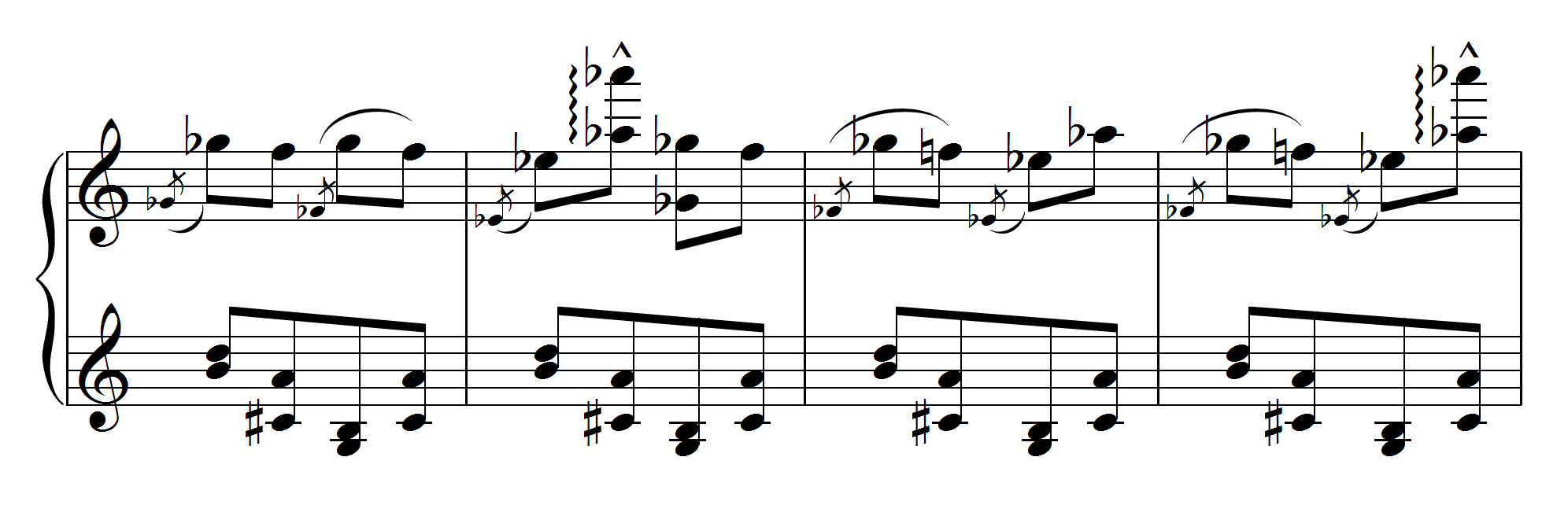“Reorganizing the notes as indicated allows pianists who cannot reach the tenth to play the whole chord simultaneously.”
Submitted by Michael Clark
Published on 1/1/2020

“Reorganizing the notes as indicated allows pianists who cannot reach the tenth to play the whole chord simultaneously.”
Submitted by Michael Clark
Published on 1/1/2020

“This fingering/hand grouping lets the hands move at different times to play the sextuplet, according to where the lines appear in the groupings. For left hand, hold thumb and release the lower note of the third, and 4 and 5 can find the next minor 2nd easily, letting your eyes focus on the right hand's jump at the same time.”
Submitted by Gabe Merrill-Steskal
Published on 3/21/2020

“Playing the final B of m. 17 with the left hand facilitates a smoother delivery of the top line, resulting in more consistent voicing. Taking the bottom of the E octave in the left hand eliminates a very awkward leap at a fast tempo.”
Submitted by Michael Clark with thanks to Robert Roux
Published on 1/1/2020

“The right-hand thumb is already on the D one eighth note before, so it’s no trouble for it to play the D in m. 54, eliminating an unnecessary position shift in the left hand. On the downbeat of m. 55, I prefer to keep the same distribution employed in the previous measures for simplicity (three notes in the left hand, one in the right).”
Submitted by Michael Clark
Published on 1/1/2020
Original:

Suggested performance:

“The F-flat grace notes in mm. 105–6 are extremely awkward when played in the right hand. Catching them with left-hand 5 eliminates the crowding.”
Submitted by Michael Clark
Published on 2/13/2022
Original:

Suggested performance:

“Redistributing the notes in m. 110 eliminates an awkward hand crossing and allows the right hand to remain in a closer position to the succeeding octaves.”
Submitted by Michael Clark
Published on 1/1/2020


“Taking the B-flat from the lower staff into the right hand in m. 158 is the only way I can manage the awkwardness of this measure. When possible, taking the grace notes in the left hand facilitates a stronger sforzando on the arrival note.”
Submitted by Michael Clark
Published on 1/1/2020
Original:

Suggested performance:

“The B-flat grace note in m. 220 is extremely awkward when played in the right hand. Catching it with finger 5 in the left hand eliminates the crowding.”
Submitted by Michael Clark
Published on 1/1/2020

“This dramatic leap is made somewhat easier by taking the preceding B octave with the left hand.”
Submitted by Michael Clark
Published on 1/1/2020

“The middle voice must be silently traded between the hands to maintain legato in all voices and clear pedaling.”
Submitted by Michael Clark
Published on 1/1/2020

“Taking the G into the right hand in m. 14 helps keep the different articulations distinct and eliminates the leaps in the left hand.”"
Submitted by Michael Clark
Published on 1/13/2022

“The bottom voice of the treble staff can be incorporated into the left hand at the end of m. 22 to avoid crowding.
Submitted by Michael Clark
Published on 1/1/2020

“The lower notes of the top staff easily fit with in the left hand’s reach.”
Submitted by Michael Clark
Published on 1/13/2022

“This hand distribution helps in observing Bartók’s articulation markings.”
Submitted by Michael Clark
Published on 1/1/2020

“Taking the G-flat in the right hand facilitates legato in the bass line.”
Submitted by Michael Clark
Published on 1/13/2022

“Switching the right and left hand seconds in m. 48 slightly reduces the stretch in the left hand (every little bit helps in this piece) and establishes the new pattern in the left hand.”
Submitted by Michael Clark
Published on 1/1/2020


“Though no hand configuration makes this passage easy, I find it easier to take the bottom voice of the top staff in the left hand to facilitate the incredibly fast right-hand sixteenth notes.”
Submitted by Michael Clark
Published on 1/1/2020

“The left hand is already on this A so it is very simple to play the A again with the same hand.”
Submitted by Michael Clark
Published on 1/1/2020